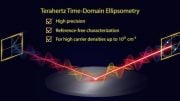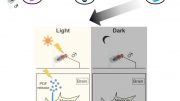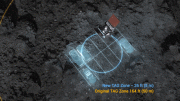
In 2021, Turkish scientist Hamdi Ucar discovered a novel form of magnetic levitation, where a rapidly rotating magnet caused a nearby magnet to levitate. This phenomenon, which defied classical physics, was replicated and studied by Professor Rasmus Bjørk and his team. They found that the levitating magnet aligns with the spinning magnet, creating an equilibrium akin to a spinning top. Credit: SciTechDaily.com
Scientists from the Technical University of Denmark (DTU) have confirmed the underlying physics of a newly discovered phenomenon of magnet levitation.
In 2021, a scientist from Turkey published a research paper detailing an experiment where a magnet was attached to a motor, causing it to rotate rapidly. When this setup was brought near a second magnet, the second magnet began to rotate and suddenly hovered in a fixed position a few centimeters away.
While magnetic levitation is nothing new – the best-known example is probably Maglev trains that rely on a strong magnetic force for lift and propulsion – the experiment puzzled physicists as this phenomenon was not described by classical physics, or, at least, by any of known mechanism of magnetic levitation.
Magnetic levitation demonstrated using a Dremel tool spinning a magnet at 266 Hz. The rotor magnet is 7x7x7 mm3 and the floater magnet is 6x6x6 mm3. This video shows the physics described in the research. Credit: DTU.
It is now, however. Rasmus Bjørk, a professor at DTU Energy, was intrigued by Ucar’s experiment and set out to replicate it with MSc student Joachim M. Hermansen while figuring out exactly what was going on. The replicating was easy and could be done by using off-the-shelf components, but the physics of it was strange, says Rasmus Bjørk:
“Magnets should not hover when they are close together. Usually, they will either attract or repel each other. But if you spin one of the magnets, it turns out, you can achieve this hovering. And that is the strange part. The force affecting the magnets should not change just because you rotate one of them, so it seems there is a coupling between the movement and the magnetic force,” he says.
The results have recently been published in the journal Physics Review Applied.
Several experiments to confirm the physics
The experiments involved several magnets of differing sizes, but the principle remained the same: By rotating a magnet very fast the researchers observed how another magnet in close proximity, dubbed a “floater magnets,” started spinning at the same speed while it quickly locked into a position where it stayed hovering.
They found that as the floater magnet locked into position, it was oriented close to the axis of rotation and towards the like pole of the rotor magnet. So, for instance, the north pole of the floater magnet, while it was spinning, stayed pointing towards the north pole of the fixed magnet.
This is different from what was expected based on the laws of magnetostatics, which explain how a static magnetic system functions. As it turns out, however, the magnetostatic interactions between the rotating magnets are exactly what is responsible for creating the equilibrium position of the floater, as co-author PhD-student Frederik L. Durhuus found using simulations of the phenomenon. They observed a significant impact of magnet size on levitation dynamics: smaller magnets required higher rotation speeds for levitation due to their larger inertia and the higher it would float.
“It turns out that the floater magnet wants to align itself with the spinning magnet, but it cannot spin fast enough to do so. And for as long as this coupling is maintained it will hover or levitate,” says Rasmus Bjørk, and continues:
“You might compare it to a spinning top. It will not stand unless it is spinning but is locked into position by its rotation. It is only when the rotation loses energy that the force of gravity – or in our case the push and pull of the magnets – becomes large enough to overcome the equilibrium.”
Reference: “Magnetic levitation by rotation” by Joachim Marco Hermansen, Frederik Laust Durhuus, Cathrine Frandsen, Marco Beleggia, Christian R.H. Bahl and Rasmus Bjørk, 13 October 2023, Physical Review Applied.
DOI: 10.1103/PhysRevApplied.20.044036









Very interesting writing about magnets and levitation and other new discoveries
Great reads
Try it in a vacuum.
However, the world is an interconnected whole. A real vacuum is almost impossible to exist, persist and be observed.
The rotation of topological vortices is spin. Spin generates energy, spin generates gravitation, spin generates time, spin generates evolution. Topological vortices can achieve a transition from chaos to order via the synchronization effect of spin. Therefore, there is a coupling between the movement and the magnetic force.
Between separated coupled magnets exists a ring-shaped intermediately-positioned “flux cross-mixing surface” acting as a locus of flux-cancellation when the magnets disagree and one of flux-sharing otherwise. Spinning one of the magnets inhibits flux cancelling and encourages flux sharing and spin-locking.
Also worth noting that there is also a locus available for flux-mixing on both poles of both magnets, not just intermediate between the facing poles, and this locus on the free magnet, along with the tendency of flux lines to shorten if allowed to do so, is enough to flip the free magnet as it enters spin lock with the other if it is not already facing the other that way.
How is that beyond classical physics; how much you want to bet the the United States Department of Defense has been spinning magnets the same way for over 70 years? And even if they haven’t, the explanation is not beyond the laws identified in classical physics.
“Magnets should not hover when they are close together. Usually, they will either attract or repel each other.”
I’ve been trying to visualize flux lines with a rotating cross section. For some reason this pole inversion of like-to-like ends reminds me of the re-focus point at the opposite end of a water bubble at the end of a faucet.
Thread can hold together by twisted fibers. If the ends of a short piece of thread are twisted one way the thread tightens, twist it the other way and the thread loosens up with an opening in the middle. I’m thinking it’s possible the spinning magnet levitation effect arises from untwisting twisted flux lines, creating a “flux bubble” opening at the tip of the spinning magnet. Not sure how to explain the re-closing of flux lines at the opposite end of the bubble other than to suppose untwisting the magnetic flux lines adds a charge effect to the lines.
Not being completely satisfied with that, I’m also thinking about some form of field percolation effect within the magnets.
Try it in a vacume chamber with quartz crystals nearby, also could be utilized if folowed corectly volcanizing metal or electrolyzing different metals with other frequencies inbeded into the equation
Thanks, but no need now. I’ve described essentially what’s happening, in a new comment, below this one, where I’ve taken a much better tack on it.
“Try it in a vacume chamber with quartz crystals nearby, also could be utilized if folowed corectly volcanizing metal or electrolyzing different metals with other frequencies inbeded into the equation”
The gallery around here is always so dead-pan.
Scratch that, here’s a better explanation:
Between separated coupled magnets exists a ring-shaped intermediately-positioned “flux cross-mixing surface” acting as a locus of flux-cancellation when the magnets disagree and one of flux-sharing otherwise. Spinning one of the magnets inhibits flux cancelling and encourages flux sharing and spin-locking.
Look up Searl Effect Generator on youtube. There is also a documentary on Prof. John Searl’s life. Unfortunately John passed away, I think in 2018.
He also created an anti-gravity device using neodymium magnets
I’m an EE, retired patent examiner. Perpetual motion with that effect is not patentable or possible, but I’m only pointing that out since you asked.
Whoever this may be. My name is Aaron. I have serious inquiries and your thought Wavelengths are decidely aling such same iF.
Care to talk knowledgeable premises a bit?
Ill start with a couple simple base points to clarify considered unbefore for thought in perspective angles.
Ill wait to hear a reply at least though i dont burden or bear my phone quite alot
Till then.
Isn’t this how the floating planet globe works?
Maybe it should be. As levitating globe toys stand now my guess is the magnets don’t spin. Interesting toy idea to motorize one or both of the levitating magnets, though. I’m thinking practical applications will gradually show up, but I’m not experienced enough in manufacturing to spot the best applications.
Maybe use two sets of magnets to levitate the globe and another set of magnets tilted a little, to spin the globe from inside, adding some sort of weak magnet-to-globe air coupling, maybe little fins on the inside surface of the globe, as the globe is not supposed to spin very fast anyway.
I suppose it’s not necessary to make the spinner magnet flip poles to get it spinning. When it flips poles it seems it should start spinning one way and then reverse spin as it flips over. The idea outlined above should work either way.
So weird. Presumably the floating magnet is both attracted at a distance but then repelled closer up, as it tries to orientate and close the gap further but can’t keep up with the spin, so the repulsion of same poles pushes back. As it falls, the attraction pulls it back again. Can’t see any use for it…
So if one magnet is a planet and the other is a spinning disk then that would maybe be useful somehow.
I am very intrigued with this topic, and would be interested in any future endeavors in this area
I had a thought about seeing if I could find a magnetism article to elaborate as a comment. Last night before falling asleep. behold I turned on the computer this morning and searched for a page from SciTechDaily a short time there after here I am, what would be the chance of finding this article, My thought has to do with a magnetic effect in a closed system like the earth and how the field of the magnetism strength gets stronger the closer to the center of the magnetic source causing a weight difference associated the magnetic field band seems to be shorter in height and with the same length from North to south and a time dilation is in effect at different altitudes from the magnet like the difference of time at a mountain top to let’s’ say sea level very small but this has been proven, so the ark of the band gets weaker and more radial the higher more distance of spred field there is to the magnets center translating to a weight. Now I consider the magnetic band akin to liquid smooth transition from a gas to a solid like water constant not incremental like the viscosity of oil it increases as the oil becomes denser,now the time dilation would be a smooth constant also and not incremental, all these aspects have a correlation of smooth constant transition all these transitions can be mathematically plotted on a graph showing point correlation energy strength and time dilation just as observed in the experiment, a question needs answering in this experiment if a fixed static magnet such as the earth where to have a rotating magnet. suspended in free space above the static magnet would the rotating magnetism levitate, maybe showing the calculated graph point of the time dilation and field band energy of the smooth repulsive interface fields where the distinction of bands have separated to repulsive smooth fixed band area do to charge spin state.I think what I am pointing at is gravities explanation and time dilation in gravity.
Whoever this may be. My name is Aaron. I have serious inquiries and your thought Wavelengths are decidely aling such same iF.
Care to talk knowledgeable premises a bit?
Ill start with a couple simple base points to clarify considered unbefore for thought in perspective angles. Well Determined that I’m gonna try to recreate an ancient era invention that was used to transfer and propagate wavelengths of sounds throughout a network of these such inventions to allow complete saturated levels of oscillating frequency inputs… and found a decent amount of materials just doing my usual walkabout to keep in touch with my environment….soooo should be interesting plus wanted to maybe slightly include a way to use such invention to ionize a solution I’ve created that allows electric transfer and retained charged and maybe play around with electroacoustic wave formations and study uses and applicability within this curious update.. Alas, A1a5…
magnetic_cymatiks Waveform_Resonance Schematics_Formula Engineering_Prototype
Smaller magnet = higher inertia? that sounds wrong to me. Must be a typo
Makes perfect sense though?
It’s badly worded. A smaller magnet calls for relatively higher spin rate in this application, and that means the magnet will be carrying relatively increased rotational inertia.
Btw, anyone except TheHack and TorboyChoreboy is welcome to check out my answer above posted at 1/9 1:02AM.
… also, the difference between “inertia” and “momentum” can be considered an arbitrary choice of “inertial rest frames.” If an object is resting within a chosen “inertial rest frame” then “inertia” best fits how it resists moving, while “momentum” characterizes the same object’s resistance to being slowed in motion relative to a different “inertial rest frame.” Same situation applies whether the motion is linear or rotational.
Then there is this from 7 years ago.
https://youtu.be/ubUM62k_aMs?si=xk26D9Pb6RvtmHZv
What happens when you place two rotating magnets next to each otjer?
Do black hole have any relation with megnatic?and from which particle this astroue space create ?please tell me
In my model of the universe gravity (and now I think magnetism, too, in certain materials) is induced by some ambient higher frequency force to radiate in pulsing lines of attractive force at a particular angle from all objects, from subatomic particles to galaxies. My own experiments with rotating wheels have demonstrated time and again that rotation intensifies gravity in the wheels and their interaction with the earth’s ambient field. Therefore, I postulate that the intensified gravity of the motor driven magnet achieves gravitational and magnetic equilibrium with the non-motor driven magnet, similar to how a rotating wheel will temporarily achieve equilibrium within the earth’s field respective of it’s angular velocity. If so, the non-motor driven magnet is not ‘hovering,’ it’s ‘captured’ by the motor driven magnet. Another good example of there being no need for theoretical ‘dark matter.’
Could this be happening with black holes resulting in spiral galaxies which levitate the stars. It could be how gravity works. No dark matter needed
Not one of you ding dongs out there from your highly physicist to your strollers mathematician nobody have said what is gravity about are they some kind of energy no I know not one of you have said or answer the question or try to say what is gravity in the first place it is connected to magnetism Denise someday I’ll let you guys know
Not one of you ding dongs out there from your highly physicist to your strollers mathematician nobody have said what is gravity about are they yes I know this is a duplicate comment yes I did said that computer error smartphone error it doesn’t matter I have posted it post my commentsome kind of energy no I know not one of you have said or answer the question or try to say what is gravity in the first place it is connected to magnetism Denise someday I’ll let you guys know
Ok so how long now until we having floating cars
The result seems consistent with the physics of non magnetic rotational bodies which also yield results that may not at first glance be intuitive. Once you put magnetic flux lines in motion you need to consider all the forces in play. Remember the right hand rule? Energy is constantly being added to the system and is being redistributed along M and E lines of flux.
It would be very interesting if the output energy from the stationary magnet could be reversed to drive the motorised magnet??? Meantime we need some mathematical models of explanation to perhaps exploit the phenonema
A changing magnetic field creates an electric field. Since the other magnet also spins, perhaps they create a static electric field of the same charge that resists the magnetic attraction.
I love the idea of this! But can this technology make the “Hoverboard” possible?
(from back to the Future 2)
A rotating magnetic field will induce an electric current in a conductor a 90 degrees to the magnetic field. An electric current induces a magnetic field in the conductor, also at 90 degrees. Basic principle of an electric motor. The magnetic field induced in the levitating magnet, being opposite of its natural magnetism, reduces the flux. The magnetic attractions and repulsions tend to balance when the phase angles are slightly lagging. If the driven magnet moves closer to the driver, the repulsion of the natural magnetic poles will increase, and if it moves further away, the attraction of the induced field will increase. A precise measurement of the rotational speeds should show a small difference, indicating a lagging phase angle, as in an induction motor.
Im tizzy dizzy forgizzy
I want to call this flux pinning effect a spin-peripheralized “centrifugally-influenced” flux-locking” effect. It’s evidence that quantum spin is a generalized form of kinetic spin in charged particles. It’s also a compound monopole effect, not truly a 1D Dirac monopole. It seemingly has a certain duality with p-orbital electron pairs.
Magnetic field reconnection also seems relevant. Magnetic flux lines want to shorten their extended loop lengths as much as possible, as if elastic, but magnets will also link up and replace most if not all individual self-flux loops, dynamically reconfiguring them, reconnecting the fluxes into more efficient collective loop fluxes.
Rotatating a magnet apparently assists in deflecting outgoing pole flux away from the rotation axis, apparently relegating magnetic couplings through the most-peripherized pole face flux lines. Normally the most centralized flux lines are the most dominant in coupling effects.
Spreading the flux lines out by rotation apparently assists in allowing opposing flux lines from both magnets to cross over with less destructive interference, much like bound electron pairs sharing a p orbital don’t interfere in crossovers between orbit lobes. Pushing the flux lines outward frustrates normal near-side elasticity while allowing connections with agreeing short loop fluxes joining to the far-side poles.
That looks like a decent explanation to me at the moment, anyway.
“Rotatating a magnet apparently assists in deflecting outgoing pole flux away from the rotation axis, apparently relegating magnetic couplings through the most-peripherized pole face flux lines”
I mean “Rotating a magnet apparently assists in deflecting outgoing pole flux away from the rotation axis, apparently relegating magnetic couplings to paths passing through the most-peripheralized flux lines.”
Also, despite rotationally splayed-out flux loops supporting direct flux link reconnections between inside poles and outside poles, a residual short-loop flux for each magnet of the pair is still keeping the magnets separate.
I might be correct that spinning a magnet will spread its flux loops out a little wider and assist the effect described by the article, but that aspect is not clear to me right now and it is supposition in an effort to see “new physics.” I’m not sure there actually is any new physics involved in the experiment, maybe just new effects. The idea that spinning a magnet can assist in cross-coupling of parallel radial fluxes doesn’t seem to be “new physics” to me although I haven’t thought about it before.
PLease stop comparing gravity with magnetism, they are two completely different atomic forces.
At one point it is stated that the north magnetic poles of both magnets are next to each other & elswhere that the levitating magnet can’t keep up with the spun magnet. Both can not be true.
All talk and debate. Yada yada yada yada. No results. No proof. No testing, just blah blah. Pseudo brains, snake oil charmers…..
Thanks for all the encouragement by not getting personal, guys.
Starting over from scratch –
As a pair of agreeing magnets are brought together, a ring-shaped intermediate zone is created where fluxes of both magnets attempt to mix together while running in opposite directions, cancelling out both fluxes. The resultant effectively flux-repulsive zone stimulates zone-avoiding flux-loop reconfigurations eventually pulling the magnets together.
Spinning one magnet not too closely to the other inhibits the action of this flux-repulsive zone.
As a pair of opposing magnets is pressed together, a ring-shaped intermediate zone is created where fluxes of both magnets successfully mix together as they naturally flow in the same directions.
Spinning one magnet stimulates the intermediate zone to become a flux crossover zone where fluxes of both magnets are encouraged to form cross-connections between the magnets.
“fluxes of both (sources) attempt to mix together while running in opposite directions, cancelling out both fluxes”
This is a key difference between electromagnetic flux and gravitational flux, as I see it, as crossing gravitational fluxes have no problem passing by each other.
In theory, flux line loops can be viewed as a vector field superposition of monopole-pair vector-field radiations, with one monopole sinking inward flows and the other monopole sourcing an always-equivalent amount of outward flows, both theoretically along straight lines mostly heading out into the void unhindered unless they connect locally. Ways of making the monopoles radiate unevenly over different angles, especially if not by moving either monopole, is beyond a quick discussion here for the time being.
Off the dipole pairing axis, the monopolar flows cross with different angles to generate the vector headings for “magnetic dipole” (normal magnet) flux lines. Reconfigurations of flux line couplings based on spinning one or more magnets seems to be common with some electric motor designs that do not spin-lock levitate anything. That includes stepping motors.
One thing to be sure of, nothing is truly final until an Einstein-worshipper adept at going in public as a dark matter research salesman has had adequate time to look it over.
This is how UAP’s levitate. They are using the Earth’s magnetic field, it spins at 1000 mph. These UAP’s are made up of a metal that must levitate at a certain Hz.